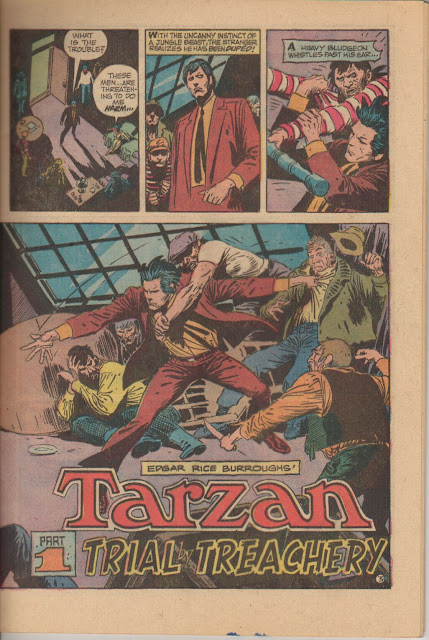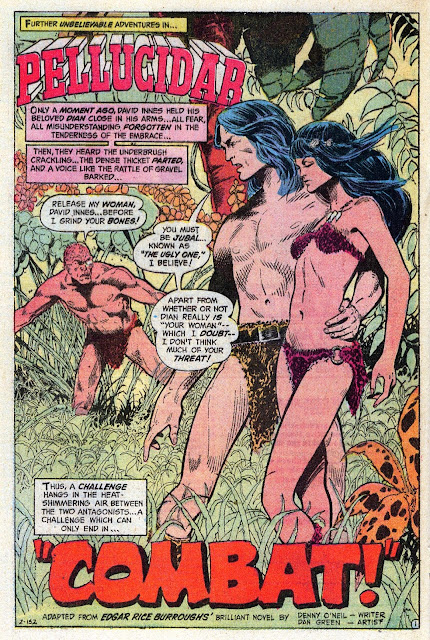Howard Chaykin: DC kept him busy on Sword of Sorcery, their horror and war mags, but the creator of Dominic Fortune and American Flagg! on drew one Batman tale during the Groovy Age. It was during Archie Goodwin's legendary run as writer/editor of Detective Comics on a tale called "Judgement Day" in 'Tec #441 (March 1974). Chaykin's art at this time hearkened back to the Golden Age, but with a definite 70s vibe that made it extra cool in my eyes. (You can read the whole story here.)
Rich Buckler: Rich did tons of covers, back-ups for Robin, Rose and Thorn, Black Lightning, Hawkman, and so many more--but he only did two Batman stories during the Groovy Age. One was the extremely gorgeous "Batman's Greatest Failure!" (from Batman #265, April 1975) which you can read here) inked by Bernie Wrightson and written by Michael Fleisher. Buckler also drew "The Mad Hatter Goes Straight" inked by Vinnie Colletta over a story by David V. Reed (Batman #297, December 1977). Rich's Batman is big and strong, powerful-yet-athletic, with a lantern jaw that would do Bob Kane proud!
Michael Netzer: Like Buckler, Netzer (known during the Groovy Age as Mike Nasser) drew only two Batman stories, but man, were they memorable jobs! On "The Dead on Arrival Conspiracy" (DC Special Series #1, June 1977), Netzer, with inker Joe Rubinstein, gives us a sleek Batman combining the best elements of Neal Adams and Jim Aparo. Just over a year later with "Hang the Batman" (DC Special Series #15, Summer 1978), Netzer and Rubinstein's talents have matured and developed into a more stylized, hyper-realistic way that points toward guys like Bryan Hitch.
Jim Starlin: Another member of the "two-fer" club, our fave cosmic artist drew a few covers and a frontispiece for Batman Family, but only two Batman tales. Both were inked/finished by P. Craig Russell and appeared in Detective Comics numbers 481-482 (September-November 1978). Starlin's uber-muscular Kirby/Ditko fusion could get "grim and gritty" (as Judo Jim had proven on Master of Kung Fu), while Russell's almost delicate inks gave the whole thing an almost Victorian look that really suited Starlin's story. (Oh, yeah, you can read those mini-epics here and here.) Starlin would return to Batman in the 1980s...as a writer.
Mike Grell: Iron Mike Grell is best known for his stellar work on Legion of Super-Heroes, Green Lantern/Green Arrow, and of course, Warlord. He did manage to squeeze in five Batman jobs; one self-inked (Detective Comics #455, October 1976, yep, read it here), two inked by Bob Wiacek (Batman 287-288, February-March 1977), and two inked by Vinnie Colletta (Batman #289-290, April-May 1977). Grell is another artist who is equally adept at both sci-fi and grit, so he was a great fit for the Darknight Detective. Lithe and graceful yet grim and powerful--yeah, Grell's Batman hinted a bit toward the even more stylized Batman of Marshall Rogers.
Walt Simonson: Okay, Wondrous Walt drew seven Groovy Age Batman tales, but that still wasn't enough for moi. Watching Simonson's style develop over those spread-out seven issues is worth a post in and of itself (help me remember to do that, fellow-babies)! Beginning with the Batman/Manhunter team-up in Detective #443 (July 1974, which you can read here), to 'Tec #450's "The Cape and Cowl Deathtrap" (May 1975, read it here)--which is my fave, with its short-eared, stocky, winged caped Gotham Goliath, to the beginning of the Steve Englehart era with the long-eared powerhouse inked by Al Milgrom in Detective Comics numbers 469-470 (February-March 1977), to Batman #300's (March 1978 read it here) Dick Giordano-finished Batman of the Future, to more Giordano-inked goodness on Batman numbers 312 and 321 (March and December 1979), Walt's Batman was always exciting and dynamic. Whaddya expect from a guy who's still wowing us with his amazing art to this very day?



























































































